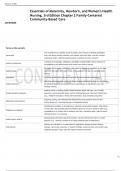9/2/24, 4:15 PM
Essentials of Maternity, Newborn, and Women's Health
Nursing, 3rd Edition Chapter 2 Family-Centered
Community-Based Care
Jeremiah
Terms in this set (63)
may be defined as a specific group of people, often living in a defined geographic
community area, who share common interests, who interact with each other, and who function
collectively within a defined social structure to address common concerns
is defined as knowledge, willingness, and ability to adapt health care to enhance its
cultural competence
acceptability to and effectiveness with clients from diverse cultures
the study of the causes, distribution, and control of disease in population, it can help
epidemiology determine the health and health needs of a population and assist in planning health
services
population is a group of individuals who share personal or environmental characterisitcs
detecting unrecognized or preclinical illness among individuals so they can be referred
Health screening for definitive diagnosis and treatment (e.g. mammogram, or Pap smear, vision and
hearing checks)
assisting clients in making health-related decisions about self-care, use of health
Health education programs resources, and social health issues such as smoking bans and motorcycle helmet laws
(e.g., childbirth education or breast self-examination, drug awareness programs)
preparing, giving, and evaluating the effectiveness of prescription and over-the-
Medication administration
counter drugs (e.g., hormone therapy in menopausal women)
identifying the problem to be addresses; listening and providing support, information,
or instruction; documenting advice/instructions given to concerns raised by caller (e.g.,
Telephone consulation
consultation for a mother with a newborn with colic, interaction with a parent whose
child has a fever or is vomiting)
passing along information about the location, services offered and ways to contact
Health system referral
agencies (e.g., referring a woman for a breast prosthesis after a mastectomy)
teaching an individual or a group about a medication, disease process, lifestyle
Instructional changes, community resources, or research findings concerning their environment (e.g.,
childbirth education class, basic life support classes for parents)
1/5
, 9/2/24, 4:15 PM
demonstrating the direct relationship between nutrition and illness while focusing on
Nutritional conuseling the need for diet modification to promote wellness (e.g., Woman, Infants, and Children
[WIC] program; counselor interviewing a pregnant woman who has anemia)
recognizing personal or group characteristic that predispose people to develop a
specific health problem, and modifying or eliminating them (e.g., genetic counseling of
Risk identification
an older pregnant woman at risk for a Down syndrome infant; genetic screening of
family members for cystic fibrosis or Huntington's disease)
involves preventing the disease or condition before it occurs through health promotion
Primary prevention
activities, environmental protection, and specific protection against disease or injury
encompasses a vast array of areas, including nutrition, good hygiene, sanitation,
immunizations, protection from ultraviolet rays, genetic counseling, bicycle helmets,
Primary prevention
handrails on bathtubs, drug education for schoolchildren, adequate shelter, smoking
cessation, family planning, and the use of a seat belts
early detection and treatment of adverse health conditions. Aimed at halting disease,
Secondary prevention thus shortening its duration and severity to get the person back to a normal state of
functioning
pregnancy testing, blood pressure evaluations, cholesterol monitoring, fecal occult
Secondary prevention blood testing, breast examinations, mammography screening, hearing and vision
examinations, and Papanicolaou (Pap) smears are examples of this level of prevention
is designed to reduce or limit the progression of a permanent, irreversible disease or
Tertiary prevention
disability
focus on minimizing and managing he effects of a chronic illness such as
cerebrovascular disease or the chronic effects of sexually transmitted infections (e.g.,
Tertiary prevention
herpes, human immunodeficiency virus [HIV], and untreated syphilis)
involve working with women who have suffered long-term consequences of violence
*Become aware of, appreciate, and become sensitive to the values, beliefs, customs,
and behaviors that have shaped one's own culture
*Examine your own sociocultural heritage to gain personal insight
Cultural awareness
*Recognize the influence of client's cultures on their health status
*Examine personal biases and prejudices toward other cultures
*Become aware of differences in personal and client's background
*Apply knowledge of social and cultural factors across multiple backgrounds
*Seek resources that increase your understanding of different sociocultural groups
Cultural knowledge
*Become familiar with culturally/ethincally diverse groups, worldviews, beliefs,
practices, lifestyles, and problem-solving strategies
*Apply relevant best evidence-based practices culturally competent care
*Learn how to perform a competent cultural assessment
Cultural skills *Assess each client's unique cultural values, beliefs, and practices without depending
solely on written facts about specific cultural groups
*Advocate for social justice to eliminate health disparities in diverse populations
*Promote safe and quality outcomes of care for all diverse individuals
*Adapt care practices and therapies to be consistent with client values and beliefs
*Respect client's sociocultural identity in a nonjudgmental manner when interacting
*Learn key words or phases of client's language to improve communication
Cultural encounter
*Engage in cross-cultural interactions with people from culturally diverse backgrounds,
such as attending religious services or ceremonies and participating in important family
events
*Participate in as many cultural encounters as possible to avoid cultural stereotyping
2/5




